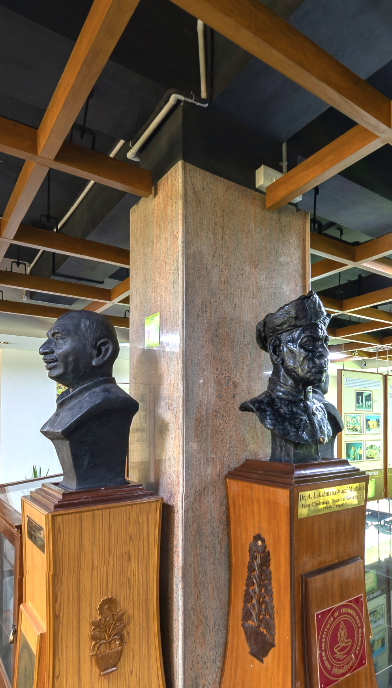Whip scorpions (Thelyphonida or Uropygi)
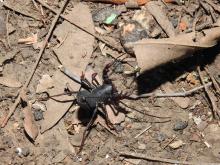
- Photographs , Flora & Fauna
Thelyphonida is an arachnid order comprising invertebrates commonly known as whip scorpions or vinegaroons. They are often called uropygids in the scientific community based on an alternative name for the order, Uropygi. The name "whip scorpion" refers to their resemblance to true scorpions and possession of a whiplike tail, and "vinegaroon" refers to their ability when attacked to discharge an offensive, vinegar-smelling liquid, which contains acetic acid. Whip scorpions range from 25 to 85 mm (1.0 to 3.3 in) in length, with most species having a body no longer than 30 mm (1.2 in). The…
Coral-tailed Cloudwing (Tholymis tillarga) (male)
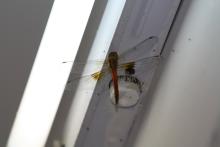
- Photographs , Flora & Fauna
The common names of this dragonfly are Evening Skimmer, Foggy-winged Twister, Coral-tailed Cloud Wing, Old World Twister, Crepuscular Darter and White-burned Dusk Hawk. The adult male Tholymis tillarga is as much carrot-orange as it is scarlet. Its distinguishing features are the unique marks on its hind wings: There is a dark spot in the middle of each hind wing, and adjoining this spot, towards the tip, is a milky white patch. These marks are conspicuous when the insect patrols over a body of water. The female and the young male are ochre in colour. The hind wings of the female do not have…
Ditch Jewel (Brachythemis contaminata) (male)
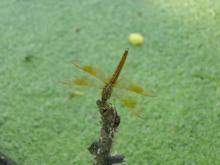
- Photographs , Flora & Fauna
Brachythemis contaminata is commonly known as Common Amber Wing, Ditch Jewel, Orange-winged Groundling or Asian Groundling. The male dragonfly of this species has a large reddish orange patch on each wing. The wing-spots are also reddish. The body is also suffused with the conspicuous reddish orange of the wings, sometimes to such an extent that the underlying longitudinal stripes are not visible. The female is duller, being brownish yellow in colour. A black series of dashes runs along the upper surface of the abdomen. This line is flanked by other, lighter lines symmetrically. Although…
Termites nuptial flight emergence (Order Isoptera)
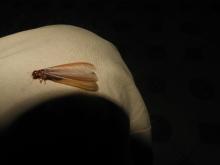
- Photographs , Flora & Fauna
Although termites are often called "white ants", they are not ants, and are not closely related to ants. Like ants and some bees and wasps from the separate order Hymenoptera, termites divide as "workers" and "soldiers" that are usually sterile. All colonies have fertile males called "kings" and one or more fertile females called "queens". Termites mostly feed on dead plant material and cellulose, generally in the form of wood, leaf litter, soil, or animal dung. Most termites construct underground colonies rather than multifunctional nests and mounds. Once a year millions of termites explode…
Termites nuptial flight emergence (Order Isoptera)
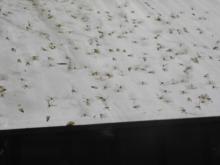
- Photographs , Flora & Fauna
Although termites are often called "white ants", they are not ants, and are not closely related to ants. Like ants and some bees and wasps from the separate order Hymenoptera, termites divide as "workers" and "soldiers" that are usually sterile. All colonies have fertile males called "kings" and one or more fertile females called "queens". Termites mostly feed on dead plant material and cellulose, generally in the form of wood, leaf litter, soil, or animal dung. Most termites construct underground colonies rather than multifunctional nests and mounds. Once a year millions of termites explode…
Senegal Golden Dartlet (Ischnura senegalensis) (male)
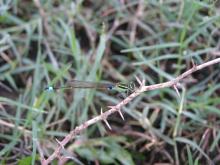
- Photographs , Flora & Fauna
The male Ischnura senegalensis is a bright insect. Its abdomen has blue and black markings at either end, and the middle section is dark above, yellowish below. The thorax is green and black. The female is found in two forms. One form is very similar to the male. This is known as the isochrome form. The other form is known as the heterochrome form. The head, thorax and first two segments of the heterochrome female’s abdomen are orange-ochre and black. The rest of the abdomen is dark above, light below. Apart from the common name Senegal Golden Dartlet, this damselfly is also commonly known as…
Greater Crimson Glider (Urothemis signata) (male)
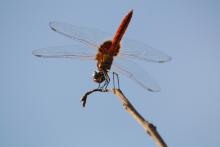
- Photographs , Flora & Fauna
The best marks of the male Urothemis signata are the prominent black patches on two segments near the tip of the abdomen. There are less distinct patches on other segments. Further, the hind wings have coloured patches on the hind wings, like a number of other species. In this species these patches are reddish or brownish, and they have a halo of yellow around. The female Urothemis signata dragonflies have golden and ochreous thoraces and abdomens. There are much bolder black spots and bands on the abdomen than in the males. The combination of colours of the female puts me in mind of a…
Greater Crimson Glider (Urothemis signata) (male)

- Photographs , Flora & Fauna
The best marks of the male Urothemis signata are the prominent black patches on two segments near the tip of the abdomen. There are less distinct patches on other segments. Further, the hind wings have coloured patches on the hind wings, like a number of other species. In this species these patches are reddish or brownish, and they have a halo of yellow around.
Grasshopper (Sub-famiy Orthacridinae, Family Pyrgomorphidae)
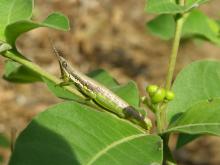
- Photographs , Flora & Fauna
Pyrgomorphidae is a family of grasshoppers in the order Orthoptera; it is the only family in the superfamily Pyrgomorphoidea, with a pan-tropical distribution. Their name is probably derived from pyrgos meaning "tower": a reference to the form (morph) of the head in this type of grasshopper. They may sometimes be known as "gaudy grasshoppers", due to the striking, often aposematic colouration. However many others are camouflaged or cryptic. Pyrgomorphs live on bushes, herbage, grasses, and sedges and on soil and sand. They perform impressive displays when annoyed or threatened. Several…
Whip scorpions (Thelyphonida or Uropygi)
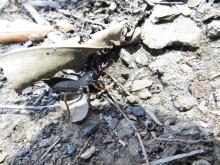
- Photographs , Flora & Fauna
Thelyphonida is an arachnid order comprising invertebrates commonly known as whip scorpions or vinegaroons. They are often called uropygids in the scientific community based on an alternative name for the order, Uropygi. The name "whip scorpion" refers to their resemblance to true scorpions and possession of a whiplike tail, and "vinegaroon" refers to their ability when attacked to discharge an offensive, vinegar-smelling liquid, which contains acetic acid. Whip scorpions range from 25 to 85 mm (1.0 to 3.3 in) in length, with most species having a body no longer than 30 mm (1.2 in). The…
Blue Ground Skimmer (Diplacodes trivialis) (female)
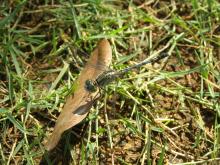
- Photographs , Flora & Fauna
This dragonfly is commonly known as the Blue Ground Percher, Blue Percher or the Ground Skimmer. Older males of this species are blue, marked with black; in females the blue is replaced by yellowish green. Younger males are similar to females. The blue colouring of the older male Diplacodes trivialisis caused by pruinescence (frosted in appearance). Diplacodes trivialisis is usually found settled on bare spots in open spaces and wanders far from water. This species has also been observed to make migratory flights.
Whip scorpions (Thelyphonida or Uropygi)
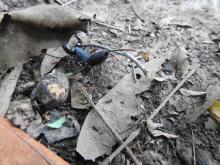
- Photographs , Flora & Fauna
Thelyphonida is an arachnid order comprising invertebrates commonly known as whip scorpions or vinegaroons. They are often called uropygids in the scientific community based on an alternative name for the order, Uropygi. The name "whip scorpion" refers to their resemblance to true scorpions and possession of a whiplike tail, and "vinegaroon" refers to their ability when attacked to discharge an offensive, vinegar-smelling liquid, which contains acetic acid. Whip scorpions range from 25 to 85 mm (1.0 to 3.3 in) in length, with most species having a body no longer than 30 mm (1.2 in). The…
Pygmy Wisp (Agriocnemis pygmaea) (two male individuals)
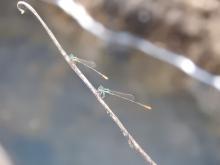
- Photographs , Flora & Fauna
This is the smallest of the Indian damselflies. The male of this damselfly is dark above and green below. But the insect is so small that this pattern is difficult to appreciate with the unaided eye. However, the tip of the abdomen is orange, and this is what registers most readily when the damselfly is viewed. Sometimes male Agriocnemis pygmaea specimens are found that have a powdery whitish coating all over the thorax and head. They look as though they have been dusted with powdered sugar. It is believed that these are older insects, and the technical name for the frosted appearance is ‘…
Hornet (Family Vespidae)
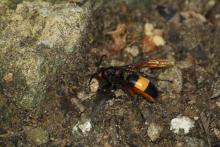
- Photographs , Flora & Fauna
Hornets (insects in the genus Vespa) are the largest of the eusocial wasps. Some species can reach up to 5.5 cm (2.2 in) in length. They are distinguished from other vespine wasps by the relatively large top margin of the head and by the rounded segment of the abdomen just behind the waist. Like other social wasps, hornets build communal nests by chewing wood to make a papery pulp. Each nest has one queen, which lays eggs and is attended by workers that, while genetically female, cannot lay fertile eggs. Most species make exposed nests in trees and shrubs, but some build their nests…
Picturewing (Rhyothemis variegata) (male)
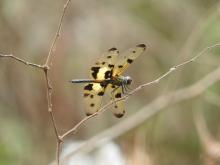
- Photographs , Flora & Fauna
Rhyothemis variegata is a striking species with a bold colour pattern. The body is dark, and the long wings are boldly marked with yellow and black patches. The patterns are strongly reminiscent of butterflies. Rishworth found the species common at St. Thomas Mount during February–March 1919. Rishworth found Rhyothemis variegata at other locations also: ‘In all my excursions in this neighbourhood I saw only one specimen of this tribe (Rhyothemis), flying high in the gardens of the Agri-Horticultural Society, Mount Road, Madras. The Chetpet Railway station, however, literally swarmed with…
- Contribute
to the Centre -
Monetary
Support - Digital
Material

